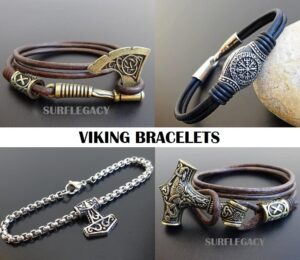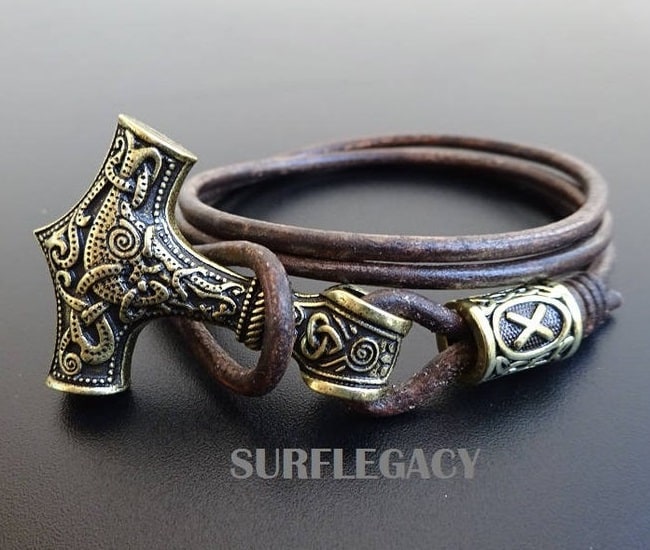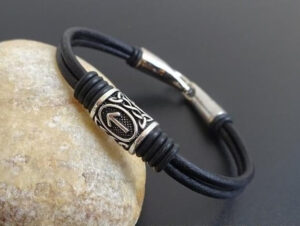In the world of antiquity, few artifacts carry as much symbolic weight as the Viking bracelet. When exploring the Viking bracelet meaning, one steps into a fascinating journey through history, culture, and artistry. These ancient adornments were not simply decorative items; they held deep significance within the Viking society, serving as symbols of wealth, status, religious devotion, and much more.
This blog post aims to illuminate the meaning behind these intricate pieces of jewelry, offering a comprehensive look into the symbolism, craftsmanship, and cultural importance that defined the Viking bracelets. As we delve into this engaging topic, we’ll better appreciate how these artifacts carry the echoes of a civilization that thrived over a thousand years ago.
The Significance of Jewelry in Viking Culture
Jewelry, in any culture, is often much more than mere decoration. In Viking society, it held a multitude of roles, each serving to reflect and reinforce the social structures and belief systems of the era. To fully grasp the Viking bracelet meaning, it’s essential to understand the general significance of jewelry within the Viking culture.
Firstly, jewelry served a practical function as a form of currency. In the absence of a standard coinage system, the Vikings often used pieces of jewelry, such as arm rings or necklaces, for trade. These items, typically made from precious metals, could be cut or broken into smaller pieces to match the value of the goods or services being exchanged.
Beyond trade, jewelry was a powerful symbol of wealth and social status. The intricacy of the design, the quality of the material, and the quantity one owned all indicated a person’s rank within the society. Bracelets, in particular, were a common form of wealth display. An individual wearing a heavy, elaborately designed Viking bracelet was likely of high status, as these pieces represented considerable material wealth.
Religion and spirituality also played a significant role in the Viking’s use of jewelry. Bracelets, alongside other pieces like amulets and pendants, were often inscribed or shaped with symbols and motifs tied to Norse mythology. The wearer of such a piece was believed to receive the protection or favor of the god or entity represented, making each bracelet a deeply personal and spiritually significant item.
Among all types of jewelry, bracelets held a unique place in Viking society. They were not only readily visible, allowing for easy display of wealth and status, but also versatile in their design and symbolism, making them an ideal canvas for the Vikings’ remarkable craftsmanship and spiritual expression. Understanding these various roles is key to appreciating the multifaceted Viking bracelet meaning.
Material and Craftsmanship: Behind the Viking Bracelet
The exceptional craftsmanship displayed in Viking bracelets is a testament to the skills and artistic prowess of the Viking smiths. To further appreciate the Viking bracelet meaning, it’s essential to understand the materials used and the techniques applied in their creation.
The primary materials for Viking bracelets were metals, specifically bronze, silver, and gold. Bronze, an alloy of copper and tin, was the most commonly used material due to its availability and relative ease of workability. Its durability and rich, warm hue made it an ideal choice for everyday wear.
Silver and gold, being more precious and rare, were used for higher-status pieces. Silver was particularly loved for its bright, reflective quality and was often associated with the moon and the goddess Freya in Norse mythology. Gold, the most precious of all, was reserved for the most elite members of Viking society and was often linked with the sun and the god Freyr.
In terms of craftsmanship, Viking smiths demonstrated great skill and creativity. They used a variety of techniques, including casting, hammering, and twisting, to create bracelets of different shapes and designs. Some bracelets were simple, consisting of plain or twisted metal bands, while others were intricate, adorned with geometric patterns, animal motifs, or runic inscriptions.
The famous “ring-money” bracelets were typically made through casting and were often designed with a distinctive flat, penannular shape. They were left open-ended, allowing the size to be adjusted and pieces to be cut off for trade. Other bracelets were formed from twisted rods of metal, creating a spiraling effect that was visually striking and demonstrated the smith’s skill.
The materials and craftsmanship behind each Viking bracelet were carefully chosen and meticulously executed, adding another layer of significance to these historical pieces. Understanding these aspects allows us to better appreciate the Viking bracelet meaning as not just a symbol of wealth or status, but also a demonstration of Viking artistry and cultural sophistication.
Symbolism and Meaning of Viking Bracelets
To fully comprehend the Viking bracelet meaning, we must delve into the rich tapestry of symbols and designs adorning these historic pieces. Vikings were deeply symbolic people, and each motif represented a specific element of their mythology, culture, or environment, infusing every bracelet with a deeper, often spiritual, significance.
One of the most common motifs found on Viking bracelets is the serpent or dragon. In Norse mythology, the serpent Jörmungandr was a formidable figure, encircling Midgard, the world of humans. Bracelets featuring this motif were believed to offer protection to the wearer, symbolizing strength and resilience.
Another prominent symbol is the Mjölnir, Thor’s hammer. Known as the god of thunder and protector of mankind, Thor was one of the most revered figures in Norse mythology. Bracelets depicting Mjölnir were popular, as they were thought to bestow Thor’s protective power upon the wearer.
The Valknut, a symbol consisting of three interlocking triangles, was also frequently used. It’s associated with the god Odin and the afterlife, symbolizing the transition between life and death. Wearing a bracelet with this symbol might have been intended to secure Odin’s favor and ensure a safe journey to the afterlife.
Viking smiths also often incorporated runic inscriptions into their designs. Runes were the letters in the alphabet used by the Vikings, and each had a specific meaning. For instance, the rune “Algiz” symbolizes protection and was commonly inscribed on bracelets.
Animals also featured prominently in Viking bracelet designs, each symbolizing different qualities. For instance, the raven, associated with the god Odin, symbolized wisdom and knowledge, while the bear, a powerful and respected animal, represented strength and bravery.
The specific symbols and designs on a Viking bracelet were believed to transfer their associated qualities to the wearer. Therefore, the bracelets were not just decorative or indicative of social status; they were also deeply personal, carrying a spiritual or protective significance for the individual Viking. Understanding these symbolic nuances enhances our appreciation of the profound Viking bracelet meaning.
The Viking Bracelet in Modern Times
While the Viking era ended over a thousand years ago, the impact of their culture, particularly their unique jewelry style, remains evident today. The Viking bracelet, with its rich history and symbolism, has found a place in modern fashion and continues to inspire contemporary jewelry design.
In today’s world, Viking bracelets are often seen as a symbol of connection to history and heritage, particularly for those with Scandinavian ancestry. They’re also worn by history enthusiasts, fans of Viking-themed media, and individuals drawn to the strength and courage often associated with the Vikings.
The revival of the Viking bracelet in contemporary jewelry can be attributed to several factors. Firstly, the distinctive Viking aesthetic, with its bold, geometric designs and intricate craftsmanship, resonates with modern tastes. Many appreciate the blend of ruggedness and artistry in Viking bracelet designs, making them a popular choice for both casual and statement accessories.
Secondly, the symbolic significance of Viking bracelets holds appeal for many. Just as the Vikings imbued their bracelets with meanings related to their beliefs and aspirations, individuals today often wear Viking-inspired jewelry as personal symbols. For instance, a bracelet featuring Thor’s hammer might be worn as a symbol of strength and protection, or a bracelet with runic inscriptions might be chosen for the specific meanings associated with the runes.
Moreover, the rise of ethically-sourced and sustainable fashion has led to an increased interest in jewelry made from durable, natural materials, much like the bronze, silver, and gold used in traditional Viking bracelets.
In modern times, the Viking bracelet meaning has evolved, shaped by contemporary interpretations and uses. However, the core elements—symbolism, craftsmanship, and cultural significance—remain central to their appeal, ensuring the Viking bracelet’s enduring relevance in the world of jewelry and fashion.
Shop Viking Jewelry
Are passionate about Vikings or Norse Myths?
Finding the ideal piece of Viking Jewelry can be challenging and time-consuming, especially if you lack inspiration or don’t know where to look.
Surflegacy, has you covered. We have a wide range of Handmade Jewelry in various styles, shapes, colors, and materials, to accentuate your Viking spirit and look. Do not hesitate to visit our selection HERE
Whatever you wear, you’ll find the ideal trendy piece to complement your wardrobe. Our jewelry is designed to be worn every day, no matter where you go or what season is. Are you ready to step up your wardrobe game?




